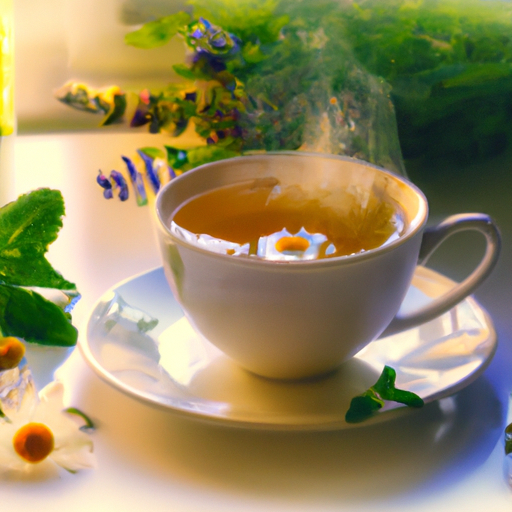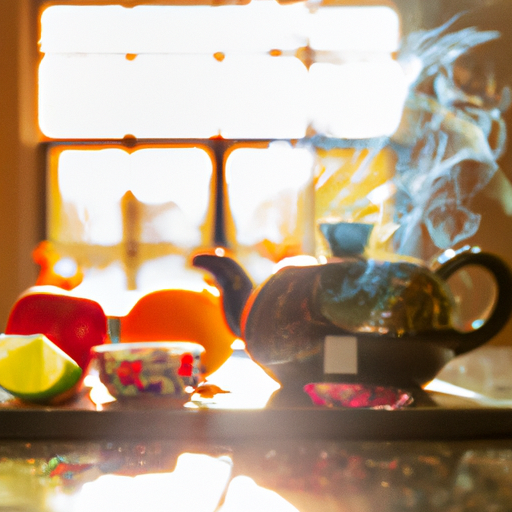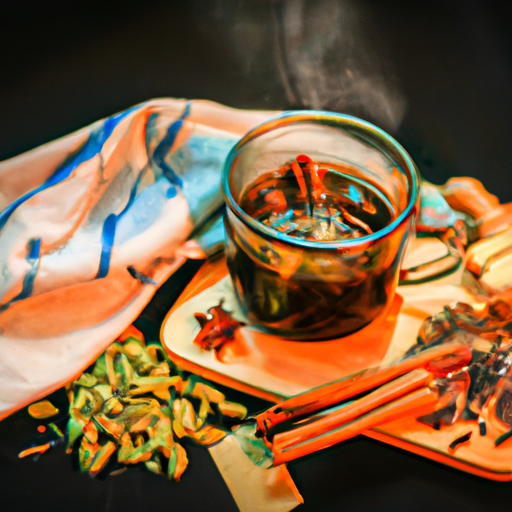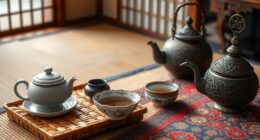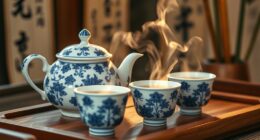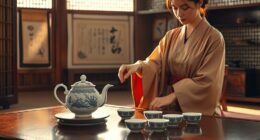What would be a good herbal tea for a headache?
As someone who has suffered from frequent headaches, I understand the desire to find a natural remedy that can provide relief. Thankfully, there are several herbal teas that have been known to help alleviate headaches.
In this article, we will explore some of the best options based on evidence and holistic practices.
- Peppermint tea is a popular choice for headaches due to its soothing and cooling properties.
- Chamomile tea, known for its calming effects, can also be effective in relieving tension headaches.
- Ginger tea, with its anti-inflammatory properties, may help reduce migraine symptoms.
- Lavender tea, with its relaxing aroma, is often used to ease stress-related headaches.
Additionally, lemon balm tea has been found to have analgesic properties, making it a potential option for headache relief. Rosemary tea, known for its antioxidant properties, may also provide some relief. Lastly, eucalyptus tea, with its invigorating scent, could help alleviate sinus headaches.
By considering these evidence-based options, you can find a herbal tea that suits your specific needs and offers a natural way to ease headache discomfort.
Key Takeaways
- Peppermint tea is a popular choice for headaches due to its soothing and cooling properties, as well as its calming effects. It can reduce the intensity and duration of tension headaches and migraines.
- Chamomile tea is effective in relieving tension headaches and promotes relaxation, providing relief from headache symptoms.
- Ginger tea is beneficial for reducing migraine symptoms as it has anti-inflammatory properties and relaxes tense muscles. It also improves blood circulation and inhibits the production of headache-triggering chemicals.
- Lavender tea eases stress-related headaches, thanks to its calming and relaxing effects. It reduces tension and stress and has sedative effects on the nervous system, aiding in headache relief.
Peppermint Tea
If you’re looking for a soothing and refreshing herbal tea to relieve your pounding headache, look no further than peppermint tea! Peppermint tea is renowned for its calming effects and has been used for centuries as a natural remedy for headaches. The menthol present in peppermint leaves helps to relax the muscles and ease tension, providing relief from the throbbing pain.
Additionally, peppermint tea has digestive benefits, which can be helpful if your headache is caused by indigestion or stomach discomfort.
Studies have shown that peppermint tea can help alleviate symptoms of tension headaches and migraines. The menthol in peppermint tea acts as a muscle relaxant, reducing the intensity and duration of headaches. Its cooling properties can also provide a soothing sensation, helping to ease the discomfort associated with headaches.
Transitioning to the next section, chamomile tea is another excellent herbal option for relieving headaches. Its gentle and calming properties make it effective in alleviating stress-related headaches. So, if peppermint tea doesn’t do the trick for you, chamomile tea might be the perfect alternative to explore.
Chamomile Tea
Chamomile tea is a soothing herbal infusion that’s been used for centuries to promote relaxation and calmness. It’s known for its calming and relaxing effects, which can help reduce tension and stress in the body.
Additionally, chamomile tea has been found to relieve headache symptoms, making it a great choice for those seeking natural remedies for their headaches.
Calming and Relaxing Effects
Lavender tea is known for its calming and relaxing effects, making it a great choice for soothing a headache. When you sip on a cup of lavender tea, you can imagine yourself in a tranquil garden, surrounded by vibrant purple flowers swaying gently in the breeze. The aroma of lavender fills the air, creating a sense of peace and serenity.
As you take a sip, you can feel the tension in your head melting away, replaced by a soothing sensation. The calming effects of lavender tea have been recognized for centuries, and it’s one of nature’s most potent natural remedies for headaches. Its gentle yet powerful properties help to reduce tension and stress, providing relief and promoting overall well-being.
Reduces Tension and Stress
When you sip on a cup of lavender tea, you’ll feel the tension in your head melt away, leaving you with a sense of calm and serenity. Lavender has long been recognized for its soothing and relaxing properties, making it an ideal herbal tea for reducing tension and stress.
Not only does lavender tea have a pleasant aroma, but it also contains compounds that promote relaxation and relieve anxiety. Scientific studies have shown that lavender can have a positive impact on the nervous system, helping to alleviate headaches caused by stress and tension.
By incorporating lavender tea into your daily routine, you can enjoy its herbal tea benefits and experience natural headache remedies.
As we delve into the next section about relieving headache symptoms, we’ll explore other effective methods to combat headaches.
Relieves Headache Symptoms
To alleviate the symptoms of a headache, you can try drinking a cup of this soothing herbal infusion. Herbal remedies have long been used for natural headache relief, and certain herbs have shown promise in providing relief from headache symptoms.
Here are three herbal options worth considering:
-
Peppermint tea: Peppermint has been found to relax muscles and improve blood flow, which can help ease headaches. It’s soothing aroma may also have a calming effect on the mind.
-
Chamomile tea: Chamomile is known for its calming properties and may help reduce tension and inflammation that can contribute to headaches. It can also promote relaxation and better sleep, which can be beneficial for headache sufferers.
-
Lavender tea: Lavender has been used for centuries to relieve headaches and promote relaxation. Its calming aroma and anti-inflammatory properties may help ease headache symptoms.
These herbal teas can be enjoyed hot or cold, and they provide a gentle and natural approach to headache relief.
Now, let’s explore the benefits of ginger tea.
Ginger Tea
Ginger tea, with its soothing properties, can be a great option for relieving a headache. Known for its calming effects and anti-inflammatory properties, ginger has been used for centuries as a natural remedy for various ailments, including headaches. The active compounds in ginger, such as gingerol and zingerone, have been shown to reduce inflammation in the body, which can help alleviate headache symptoms.
Drinking ginger tea can help relax tense muscles and improve blood circulation, which may contribute to headache relief. The warm and comforting nature of ginger tea also provides a sense of relaxation and well-being, further aiding in headache relief. Additionally, ginger has been found to inhibit the production of certain chemicals in the body that can trigger headaches, making it an effective holistic option for headache management.
However, it’s important to note that ginger tea may not work for everyone, as the effectiveness of herbal remedies can vary from person to person. If ginger tea doesn’t provide sufficient relief, another herbal option to consider is lavender tea, which is known for its calming and stress-relieving properties.
Transitioning into the next section, lavender tea can be a soothing alternative for those seeking relief from headaches.
Lavender Tea
Lavender tea is like a soothing symphony for your senses, transporting you to a field of blooming flowers with just one sip. Known for its calming properties, lavender has been used for centuries to promote relaxation and reduce stress. This fragrant herbal tea is a gentle sleep aid, perfect for those seeking a natural remedy for insomnia or restlessness.
When brewed, lavender tea releases essential oils that have been shown to have sedative effects on the nervous system, promoting a sense of calm and tranquility. This makes it an excellent choice for those suffering from headaches, as stress and tension can often be contributing factors.
To further understand the benefits of lavender tea, let’s take a look at a table summarizing its calming properties and sleep aid benefits:
| Calming Properties | Sleep Aid Benefits | Other Benefits |
|---|---|---|
| Reduces anxiety | Improves sleep quality | Relieves mild pain |
| Eases stress | Promotes relaxation | Enhances mood |
| Soothes headaches | Reduces insomnia | Supports digestion |
As we transition to the next section about lemon balm tea, it’s important to note that both lavender and lemon balm teas offer natural remedies for headaches, but each with its unique properties and benefits.
Lemon Balm Tea
Imagine yourself sipping on a warm cup of lemon balm tea, feeling your worries melt away and your mind becoming calm and clear. Lemon balm tea is not only a delicious and refreshing herbal beverage, but it also offers numerous benefits for soothing a headache.
This aromatic tea has been used for centuries to alleviate migraines and tension headaches, thanks to its natural calming properties. One of the key benefits of lemon balm tea is its ability to relax the mind and body. It contains compounds that help reduce stress and anxiety, which are common triggers for headaches.
Additionally, lemon balm tea has been found to have mild sedative effects, making it an excellent choice for those struggling with headaches caused by tension or insomnia. To prepare a cup of lemon balm tea, start by boiling water and adding a teaspoon of dried lemon balm leaves or a couple of fresh leaves to a teapot. Let it steep for about 5 minutes to allow the flavors and beneficial compounds to infuse into the water. You can add a teaspoon of honey or a slice of lemon to enhance the taste, if desired.
As you finish your soothing cup of lemon balm tea, you’ll be ready to explore the benefits of rosemary tea and discover another herbal remedy for headaches.
Rosemary Tea
After exploring the benefits of Lemon Balm tea, let’s dive into the world of Rosemary tea as another potential herbal remedy for headaches.
Rosemary, a fragrant herb often used in cooking, has been praised for its numerous health benefits. Not only does it add a delightful aroma to dishes, but it also contains compounds that’ve been found to possess anti-inflammatory and analgesic properties, which may help alleviate headaches.
Drinking a cup of Rosemary tea can be a soothing way to find relief from a headache. To make this herbal infusion, simply steep a teaspoon of dried rosemary leaves in a cup of hot water for about 10 minutes. Strain the tea and enjoy its earthy flavor and calming effects.
Rosemary’s analgesic properties, combined with its ability to promote relaxation, make it a promising option for those seeking a natural remedy for headaches. However, it’s essential to remember that individual responses to herbal remedies may vary, and it’s always a good idea to consult with a healthcare professional if you have any concerns or underlying health conditions.
Now, let’s continue our exploration of herbal teas for headaches by delving into the benefits and recipe of eucalyptus tea.
Eucalyptus Tea
To experience the refreshing and invigorating effects of eucalyptus tea, steep a few leaves in hot water and let its revitalizing aroma transport you to a rejuvenating oasis. Eucalyptus tea offers a range of benefits that can help alleviate headaches and promote overall wellness. This herbal tea contains compounds such as cineole, which possesses anti-inflammatory and analgesic properties.
Brewing eucalyptus tea is a simple process. Start by boiling water and adding a handful of fresh or dried eucalyptus leaves. Allow the leaves to steep for about 10 minutes, ensuring that the water is hot enough to extract the beneficial compounds. Strain the leaves and enjoy the soothing aroma and taste of this herbal infusion.
The benefits of eucalyptus tea extend beyond its aromatic qualities. When consumed, eucalyptus tea can help relieve sinus congestion, which is often a common cause of headaches. The anti-inflammatory properties of eucalyptus can also reduce inflammation in the blood vessels, helping to alleviate headache pain.
In addition to its headache-relieving properties, eucalyptus tea is known to have antimicrobial effects, promoting a healthy immune system. It can also support respiratory health, as it helps to clear the airways, making it easier to breathe.
Incorporating eucalyptus tea into your routine can provide a natural and holistic approach to addressing headaches, while also promoting overall well-being.
Frequently Asked Questions
Can herbal teas completely cure a headache?
Herbal teas have numerous benefits, including potential headache relief. While they may not completely cure a headache, they can provide soothing effects and help alleviate symptoms. They are a great alternative to traditional remedies.
How long does it take for herbal teas to start relieving a headache?
Herbal teas can start relieving a headache within 20-30 minutes. To choose the best tea, consider peppermint for its soothing properties or chamomile for relaxation. Incorporate teas into your daily routine for headache relief by sipping them slowly and regularly.
Are there any potential side effects or contraindications of using herbal teas for headaches?
There are potential interactions and precautions to consider when using herbal teas for headaches. It’s important to research specific types of headaches and choose herbal teas that are known to be effective and safe.
Can children or pregnant women safely consume herbal teas for headache relief?
Children and pregnant women should exercise caution when consuming herbal teas for headache relief due to potential safety concerns. Efficacy of herbal teas may vary between age groups, and more research is needed to establish their effectiveness in these populations.
Are there any specific dosages or brewing methods recommended for using herbal teas to alleviate headaches?
Different herbal teas such as chamomile, peppermint, and lavender can help alleviate headaches. For optimal benefits, steep 1-2 teaspoons of dried herbs in hot water for 10-15 minutes. Strain and enjoy.
Conclusion
In conclusion, when it comes to finding a herbal tea to soothe your headache woes, the options are plentiful. From the refreshing and invigorating peppermint tea to the calming and comforting chamomile tea, there’s a remedy for every head-pounder out there.
And let’s not forget the healing powers of ginger tea, lavender tea, lemon balm tea, rosemary tea, and eucalyptus tea. These herbal elixirs have been praised for their holistic benefits and evidence-based healing properties.
So, next time you’re in need of some headache relief, brew yourself a cup of nature’s finest and let the herbs work their magic. Cheers to a headache-free life!

